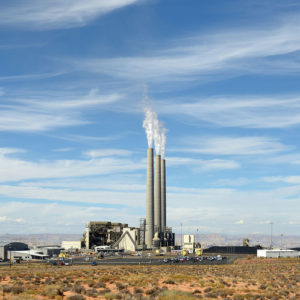When President Donald Trump announced that he was repealing the Clean Power Plan, America’s coal industry heaved a sigh of relief. Repealing the Clean Power Plan eased restrictions on coal burning power plants, which consume much of the coal mined in the U.S. However, government regulations aren’t the only threat to the coal industry. With the rapid growth of shale oil production in the Bakken oil fields of North Dakota and in small fields elsewhere in the country, a new supply of cheap natural gas has also flooded the energy market, leaving some concerned about coal’s viability. This is why some observers are pleased by a recent study showing that the Navajo Generating Station in Arizona can remain competitive despite low natural gas prices.
According to the study, which was conducted by Navigant, a consultancy, and commissioned by Peabody Energy, the Navajo Generating Station will continue to be a low-cost option for electricity through 2040, saving ratepayers approximately $160 million over that period. This date would conclude the plant’s planned 70-year life.
The Navajo Generating Station is a coal burning power plant in northern Arizona. Built in 1974, it provides electricity for area residents, in addition to providing power to pump water through central Arizona as part of the Bureau of Reclamation’s Central Arizona project. At the time, alternative sources of power, including nuclear and hydroelectricity had been considered for the pumping project. In the end, coal won out because it would allow Arizona to use its own natural resources and would provide jobs in the state.
The station is powered by coal dug from the Kayenta mine roughly 95 miles southeast of the plant. The mine itself is located on land leased from the Navajo tribe by Peabody Energy. Together, the Navajo Generating Station and the Kayenta mine play an important role in the area’s economy. The mining industry created $430 million of direct and indirect benefits to the area economy in 2016. This includes not only wages, but also increased economic activity in related industries.
The study found that, were Arizona to switch to natural gas for its power, the state would need to import essentially all of the gas, primarily through the El Paso pipeline. By contrast, continued operation of the Navajo Generating Station would allow the state to rely on an energy resource that does not need to be imported.
Importing means that Arizona would be less protected from price fluctuations, which the study noted were one contributing factor to California’s energy crisis in 2000 and 2001.
“Arizona does not have the natural gas storage to buffer price increases or supply disruption,” said Peabody in a press release.
While the report found that the Navajo Generating Station was profitable with low natural gas prices, it also found that coal would become an even stronger option if natural gas prices stabilize.
For the Navajo Nation and Hopi Tribe, the plant provides both lease revenues as well as jobs and is an important part of the tribal economies. The mine itself employs 325 people, the majority of them Native Americans.
“The power plant and mine that fuels it are vital to the jobs and economic strategy of the Navajo Nation,” said Navajo President Russell Begaye. “The Nation has taken a seat at the table with stakeholders who are committed to keep the plant operating long term. This study provides important new information demonstrating the plant can continue to be competitive well into the future.”
His statement was echoed by Hopi Tribe Chairman Herman Honanie, who called the Navajo Generating Station “a beacon for energy production in the Southwest.”
“Working together we can find solutions to see that the plant keeps operating over the long haul,” said Honanie.
The report was welcome news as Peabody emerged from Chapter 11 bankruptcy protections on Tuesday. Peabody Energy is the U.S.’s largest coal producer and filed for bankruptcy protections in April 2016 after a sharp drop in coal prices left the company unable to service its debt. Peabody Energy has been operating the Navajo Generating Station since it opened.

